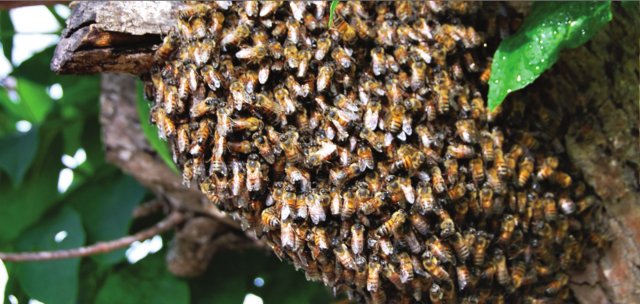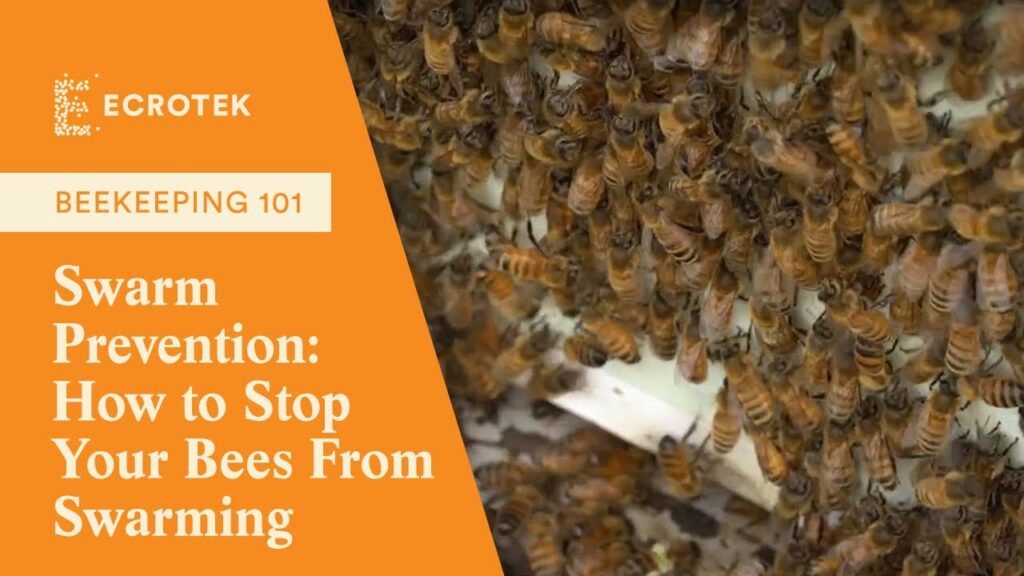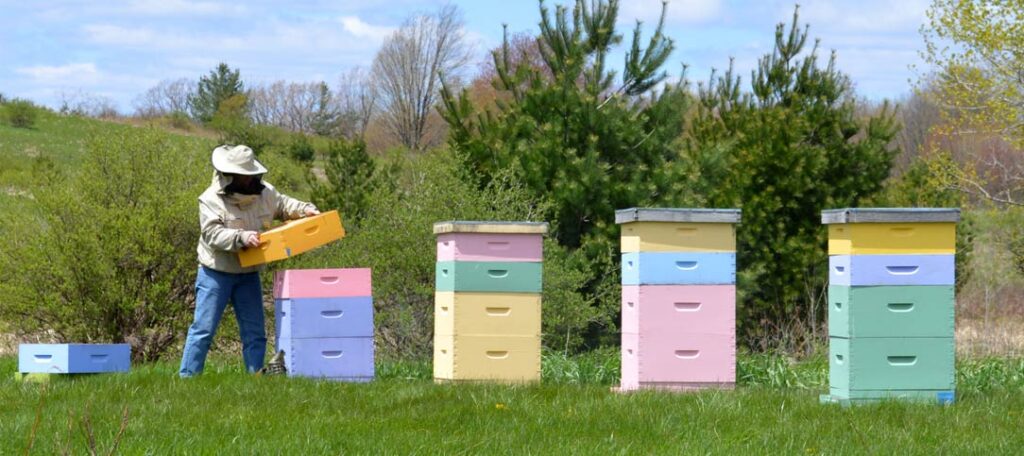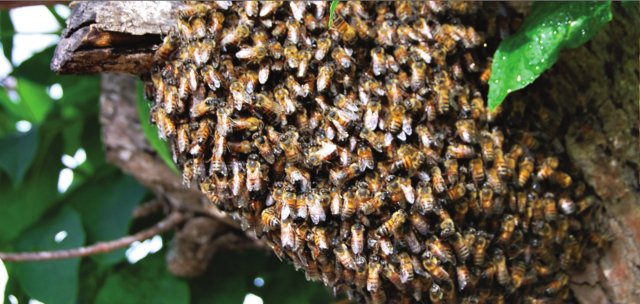
Are you concerned about bees swarming on your property? Discover effective strategies to prevent bee swarms and ensure a harmonious coexistence with these vital pollinators. From understanding the behaviors and triggers that lead to swarming to implementing simple measures in your garden, you can play a crucial role in maintaining bee populations while keeping your surroundings bee-free.

Understanding Bee Swarm Behavior
What is a bee swarm?
A bee swarm refers to a large group of bees, typically thousands of individuals, that leave their original hive to start a new one. The process of bee swarming is a natural phenomenon and an essential part of the reproductive cycle of honeybee colonies.
Why do bees swarm?
Bees swarm to reproduce and expand their population. When a hive becomes overcrowded, the bees sense the need for a new home. This triggers the development of new queen cells and the preparation for swarming. The old queen, along with a large number of worker bees, leaves the hive in search of a suitable location to establish a new colony.
When do bees swarm?
Bees typically swarm during the spring and early summer months when the colony population is at its peak. The exact timing of swarming varies depending on factors such as climate, food availability, and genetic traits of the bee species. It is essential for beekeepers to be prepared during this period to prevent the loss of valuable colonies.
How long does a swarm last?
The duration of a bee swarm can vary depending on various factors such as weather conditions and the availability of a suitable nesting site. On average, a swarm may stay clustered in a temporary location for a few hours to a couple of days before finding a suitable place to establish a new hive. It is crucial to act promptly and capture the swarm if you wish to prevent the loss of bees.
Signs of an Impending Swarm
Increased activity around the hive
One of the first signs of an impending bee swarm is a noticeable increase in bee activity around the hive. Bees may be seen flying in and out more frequently, performing orientation flights, and displaying overall restlessness. This heightened activity is an indication that the bees are preparing to leave the hive and swarm.
Queen cells being built
Another clear sign of an impending swarm is the construction of queen cells within the hive. Queen cells are larger and easily distinguishable from regular worker cells. These special cells are built by worker bees to raise new queens. If you observe queen cells in the hive, it is a clear signal that the bees are preparing to replace their current queen and potentially swarm.
Decreased honey production
a decline in honey production can also be an indication that a swarm is imminent. As the bees start preparing to leave the hive, their focus shifts from honey production to reproductive activities. Worker bees may start consuming the available honey stores to generate energy for swarming, leading to a decrease in surplus honey production.
Bees practicing orientation flights
Before swarming, bees often engage in orientation flights outside the hive. These flights involve bees flying in circles around the hive entrance, familiarizing themselves with the surrounding area. If you notice numerous bees performing orientation flights, it is a sign that swarming is likely to occur soon.
Preventing Bee Swarming
Maintain a healthy hive
Keeping a healthy hive is crucial in preventing swarming. Ensure that the bees have a consistent and balanced diet by providing sufficient food sources. Regularly monitor the hive for any signs of diseases or pests and take appropriate measures to control them. By maintaining a healthy environment, you can reduce the likelihood of swarming.
Provide adequate space
Crowded hives are more prone to swarming, so it is essential to provide adequate space for the bees. Regularly assess the colony’s population and add additional supers or boxes as necessary. Sufficient space within the hive gives the bees room to expand, reducing the urge to swarm and find a new nesting site.
Regularly inspect the hive
Frequent hive inspections are crucial in identifying any signs of swarming. By closely observing the hive’s population, honey stores, and queen status, you can anticipate when swarming is imminent. Regular inspections also help you maintain a healthy hive and address any issues that may lead to swarming.
Replace an aging queen
An aging queen is more likely to produce pheromones that signal to the worker bees that it is time to swarm. To prevent swarming, consider replacing an aging queen before the swarming season begins. Introducing a young and vigorous queen will help maintain hive stability and reduce the urge to swarm.
Use swarm traps
Swarm traps can be an effective preventative measure to capture swarms before they leave the hive. These traps are designed to attract the scouting bees searching for a suitable nesting site. By placing swarm traps in strategic locations near your hive, you increase the chances of capturing a swarm and preventing their departure.
Maintaining a Healthy Hive
Feed the bees when nectar is scarce
During periods of nectar scarcity, such as late winter or drought, it is crucial to supplement the bees’ diet. Provide them with sugar syrup or fondant to ensure they have enough food to sustain themselves. By addressing their nutritional needs, you contribute to the overall health and stability of the hive, reducing the likelihood of swarming.
Provide a water source
Bees require water for various purposes, including temperature regulation and diluting honey stores. To prevent bees from seeking water sources outside the hive, ensure they have access to a clean and reliable water source nearby. This reduces the chances of the bees leaving the hive in search of water and potentially swarming.
Manage pests and diseases
Regularly monitor the hive for signs of pests and diseases and take necessary measures to manage them effectively. Varroa mites, small hive beetles, and diseases such as American foulbrood can weaken the colony and increase the likelihood of swarming. Implement appropriate control methods to keep the hive healthy and prevent swarming.
Ensure good ventilation
Proper ventilation is crucial for maintaining optimal hive conditions and preventing the bees from feeling cramped or overheated. Adequate airflow helps regulate temperature and humidity levels within the hive, reducing stress on the bees and minimizing the urge to swarm. Consider using screened bottom boards or ventilation boxes to enhance airflow.
Avoid excessive disturbance
While regular hive inspections are necessary, it is important to avoid excessive disturbance to the bees. Too much disturbance can disrupt the colony’s stability and trigger swarming. Plan your inspections carefully and avoid unnecessary disruptions to the hive, especially during critical periods when swarming is more likely to occur.

Proper Hive Management
Add supers when necessary
Supers, also known as honey supers or honey chambers, are additional boxes placed on top of the hive to provide extra space for honey storage. Assess the honey stores within the hive regularly and add supers as needed. Adequate storage space helps prevent congestion and reduces the chances of swarming due to limited hive capacity.
Ensure proper ventilation
Proper ventilation is crucial throughout the hive, not just in the brood chamber. Adequate ventilation helps regulate the moisture levels within the hive and prevents the build-up of excess heat. Ensure that all boxes and supers have proper ventilation to maintain a healthy environment and minimize the chances of swarming.
Space frames evenly
When adding frames to the hive, ensure they are spaced evenly to allow for easy movement of bees and reduce the risk of crowding. Properly spaced frames provide sufficient access for the bees to perform their tasks, such as building comb, storing honey, and caring for brood. Well-spaced frames contribute to a balanced hive and help prevent swarming.
Monitor honey stores regularly
Regularly monitoring the honey stores within the hive is essential for preventing swarming. Bees require a sufficient supply of honey to sustain themselves, especially during periods of nectar scarcity. By keeping track of honey levels, you can anticipate when additional space or feeding may be required, reducing the chances of swarming due to inadequate food stores.
Inspecting the Hive
Look for queen cells
During hive inspections, pay close attention to the presence of queen cells. Queen cells are typically larger, elongated, and positioned vertically on the comb. Their presence indicates that the bees are preparing to replace the current queen and potentially swarm. Remove the queen cells if swarming is not desired or take appropriate measures to manage the swarming process.
Check for signs of congestion
Congestion within the hive can indicate that the bees are reaching their maximum population capacity, increasing the chances of swarming. During inspections, observe the density of bees and assess whether additional space is needed. Adding supers or expanding the hive can alleviate congestion and reduce the urge to swarm.
Ensure the queen is laying properly
A queen’s ability to lay eggs is vital for maintaining hive stability and preventing swarming. During inspections, check that the queen is actively laying eggs in a consistent pattern across the frames. If there are signs of a decrease in egg-laying or irregular patterns, it may indicate a problem with the queen’s health or productivity. Take appropriate measures to address the issue promptly.
Monitor population size
Regularly monitoring the population size of the hive is important in preventing swarming. An overcrowded hive is more likely to swarm. Assess the number of bees in the colony and observe whether they have sufficient space and resources to thrive. If the population is growing rapidly or nearing maximum capacity, take preemptive measures to prevent swarming.

Replacing an Aging Queen
Recognizing an aging queen
Identifying an aging queen can be challenging, but there are certain signs that can indicate her declining productivity. Reduced egg-laying, irregular brood patterns, or decreased pheromone production are common indications of an aging queen. By recognizing these signs, you can proactively plan to replace the queen and prevent swarming.
Introducing a new queen
Introducing a new queen is an effective way to prevent swarming caused by an aging queen. Select a young and vigorous queen from a reputable breeder or supplier. Ensure that she is in good health and has been properly mated. Introduce the new queen following appropriate techniques, such as the use of queen introduction cages, to ensure a successful transition and stability within the hive.
Methods for queen introduction
There are several methods for introducing a new queen to a hive. Some common techniques include the use of queen cages, direct release, and newspaper introduction. Each method has its advantages and considerations, so it is important to choose the method that best suits your hive and the specific circumstances. Proper queen introduction helps maintain hive stability and reduces the urge to swarm.
Using Swarm Traps
What are swarm traps?
Swarm traps are specially designed containers or structures used to attract and capture swarms of bees. These traps mimic the natural nesting sites that bees prefer, enticing them to investigate and potentially establish a new colony within the trap. Swarm traps are valuable tools for beekeepers to capture swarms and prevent the loss of valuable bees.
How do swarm traps work?
Swarm traps work by providing an inviting and enticing environment for scout bees in search of a new nesting site. They are typically baited with attractants such as old brood comb, propolis, or pheromones to make them more appealing to the bees. Once scout bees discover the trap and determine it as a suitable location, they communicate its desirability to the rest of the swarm, leading them to cluster and establish a new colony within the trap.
Placement and maintenance of swarm traps
To effectively use swarm traps, proper placement and maintenance are crucial. Place the traps in strategic locations near your apiary, high off the ground, and preferably facing south or southeast to catch the early morning sun. Regularly inspect and maintain the traps, ensuring they remain clean, attractant-scented, and in good condition. Regular monitoring and tracking of the traps increase the chances of capturing swarms and preventing their departure.

Capturing and Relocating Swarms
Safety precautions
Capturing and relocating swarms should be done with utmost care and consideration for safety. Always wear appropriate protective gear, including a bee suit, veil, and gloves, when handling swarms. Have a well-equipped beekeeping toolbox ready with essential tools such as a swarm box, hive body, frames, and a bee brush. Stay calm and avoid sudden movements to minimize agitation of the swarm.
Preparing the equipment
Before capturing a swarm, ensure that all necessary equipment is prepared. Assemble the swarm box or hive body, ensuring that frames are properly spaced and ready to accommodate the swarm. Have additional frames, foundation, and sugar syrup available in case the swarm requires extra care or feeding. Make sure all tools are clean and in good working condition.
Capturing the swarm
To capture a swarm, gently shake or brush the bees into the prepared swarm box or hive body. Be cautious not to harm the bees or the queen during the process. If the swarm is on a branch or other elevated surface, carefully cut or shake the branch to dislodge the bees into the box or hive. Use a bee brush to gently guide the remaining bees towards the box’s entrance.
Relocating the swarm
Once the swarm is captured, promptly relocate it to a suitable location. Transfer the bees into a designated hive by gently pouring or shaking them from the swarm box or hive body into the hive frames. Ensure that the hive is properly set up with adequate resources and space to accommodate the swarm. Place the hive in a quiet and sheltered area, allowing the bees to settle and establish their new home.
Conclusion
Understanding bee swarm behavior is essential for beekeepers to prevent the loss of valuable colonies and maintain hive stability. By recognizing the signs of an impending swarm and implementing preventative measures such as maintaining a healthy hive, providing adequate space, and using swarm traps, beekeepers can successfully prevent swarming and ensure the thriving of their bee colonies. Regular hive inspections, proper ventilation, and monitoring of honey stores also contribute to hive management and swarming prevention. By following these practices and implementing effective hive management techniques, beekeepers can enjoy the benefits of a productive and stable apiary.
